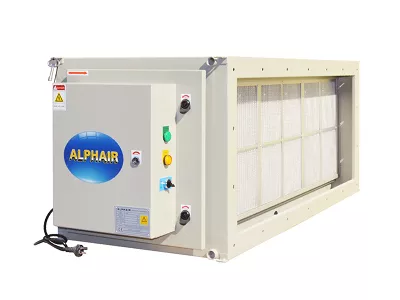1:What is Commercial Kitchen Exhaust Air?

According to the definition of relevant national standards (GB18483-2001), commercial kitchen exhaust air refers to cooking fume which consists of the oil, organic matter and its thermal decomposition or pyrolysis products that volatilize during food cooking and processing.
2: Is "Kitchen Exhaust Air" an "accomplice" to the Smog?

3 What Is the Main Components of Kitchen Exhaust Air?
Cooking oil at a high temperature above 220 °C will produce a large amount of volatile edible oil pyrolysis products and part of the volatile edible oil itself. The mixture of smoke produced by edible oil under high-temperature conditions is collectively called cooking oil fume.

In traditional Chinese cooking methods such as frying, frying, panning, frying, etc., a large number of short-chain aldehydes, ketones and polycyclic aromatic hydrocarbons can be produced. Substances, these substances are mixed together to form oil fume. The composition of oil fume components has the highest aldehyde content. Although polycyclic aromatic hydrocarbons have low content, they become the most dangerous components in oil fume due to their reproductive toxicity, carcinogenicity and mutagenicity.
4 What Should be Done for Commercial Kitchen Exhaust Air?
(1) Installation and normal use of qualified and matched oil fume purification facilities can effectively reduce kitchen exhaust air pollution. The catering service industry that emits oil fume should correctly install oil fume purification facilities and keep them in normal use, so that the oil fume discharges up to the standard, and prevent pollution to the normal living environment of nearby residents.
ALPHAIR™ kitchen electrostatic precipitator is specially designed for commercial kitchen exhaust air pollution control.
- ≥ 95% high-efficiency at a low, constant pressure drop
- 100% compliance with local air quality laws and regulations
- Washable corrosion-resistant A5052 aluminum-alloy filter, long life span.
- ASHRAE 52.1 and EN779 tested, CE certified,ISO9001.
- Trusted by LG, Microsoft, Hilton, etc.
(2) Clean and maintain regularly and record in time
The installed oil fume purification facilities need to be cleaned and maintained regularly, and the operation and maintenance of the oil fume purification facilities should be recorded in time by special personnel.
Small Sacle Unit: Should be cleaned at least every season.
Medium Scale Unit: Should be cleaned at least every two month.
Large Scale Unit: Should be cleaned at least every month.
Table 1 Scale Division of Catering Service Units (with Stove)
| Scale | Small | Medium | Large |
| Stoves QTY | ≥1,<3 | ≥3,<6 | ≥6 |
| The Total Power Of Stove Head(108J/h) | 1.67,<5.00 | ≥5.00,<10 | ≥10 |
| The Total Projected Area Of The Exhaust Hood(m2) | ≥1.1,<3.3 | ≥3.3,<6.6 | ≥6.6 |
Table 2 Scale Division of Catering Service Units (without Stove)
| Scale | Small | Medium | Large | |||
| Dining Seat (Seat) | ≤40 | >40, ≤75 | >75, ≤150 | >150, ≤200 | >200, ≤250 | >250 |
| Number of Reference Stoves (Pieces) | 1 | 2 | 3 | 4 | 5 | ≥6 |
| For a catering service unit with more than 250 seats, each additional 50 seats is regarded as an increase in the number of base stoves | ||||||
5 What Happens If Kitchen Exhaust Air Control Facilities are Not Installed and Used According to The Regulations?
NO1, the National Standard of the People’s Republic of China GB18483-2001 “Fume Emission Standard for Catering Industry” stipulates: “catering industry units that emit lampblack must install lampblack purification facilities and ensure that they operate as required during operation.
NO2, Article 81 of the Law of the People’s Republic of China on the Prevention and Control of Air Pollution: catering service operators that emit oil fume shall install oil fume purification facilities and maintain normal use, or take other oil fume purification measures to meet the emission standards and prevent pollution caused by the normal living environment of nearby residents
NO3. Article 118 of the Law of the People’s Republic of China on the Prevention and Control of Air Pollution: In violation of the provisions of this law, catering service operators who emit oil fume have not installed oil fume purification facilities, used oil fume purification facilities abnormally, or have not adopted other oil fume purification Measures that exceed the emission standards and discharge soot, the supervision and management department determined by the local people’s government at or above the county level shall order corrections and impose a fine of 5,000 CNY up to 50,000 CNY; if they refuse to make corrections, they shall be ordered to suspend business for rectification.


